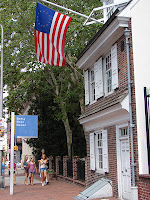Did you know that a vexillogist is a flag maker? Vexillogy is the scientific study of the history and usage of flags. We learn in school that Betsy Ross designed the American flag. But did she really? My husband and I have visited the Betsy Ross House in Philadelphia several times. Legend has it that she made the first flag but there is no documented evidence that says she did which is always dilemma for historians. However, there are several factors that made it likely that Betsy did indeed create the first American flag. She was in the right place at the right time and knew the right people. A relative of her late husband was on the flag committee and on May 29, 1777, Betsy Ross was paid a large sum of money from the Pennsylvania State Navy Board for making flags. On June 14, 1777, Congress adopted the Stars and Stripes as our official national flag. They do claim that Betsy Ross is the one who designed the five-pointed star that is on the flag basically because it was easier than making a six-pointed star. She could fold the cloth and cut it in one snip. Regardless, the Betsy Ross house is a fascinating place to visit if only to get a glimpse into life during Revolutionary times. Her house was built around 1740 and considered a variation of a "bandbox" style house, with one room on each floor and a winding staircase stretching from the cellar to the upper levels.
Another flag legend deals with Fort Stanwix Fort Stanwix
Francis J. Bellamy, of Rome , NY America was part of the official program. The Pledge was published in the September 8, 1892, issue of the magazine, and the rest is history as they say.
One of America ’s most iconic flags is the Star Spangled Banner made famous in the poem written during the War of 1812 by Francis Scott Key and later set to music. The Star-Spangled Banner that flew over Fort Sumter is on permanent exhibit at the Smithsonian in a new two-story display chamber that protects the flag while allowing an excellent view of the “broad stripes and bright stars.” The exhibition surrounding this chamber tells the dramatic story of the flag and traces its journey from the home of the maker of the flag, Mary Pickersgill, to the Smithsonian.


